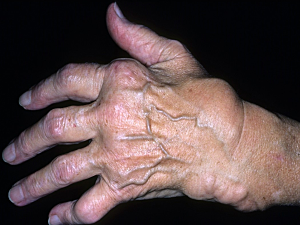Advances over the past two decades in next-generation sequencing and precision medicine have shown that cancer should be defined not only by its location in the body, but also by the specific molecular changes driving each person’s disease. For several years, experts at Brigham and Women’s Hospital have taken a similar, molecular-driven approach to studying the underpinnings of autoinflammatory disease—specifically rheumatoid arthritis (RA) and systemic lupus erythematosus (SLE).
One of the leaders in this work is Michael B. Brenner, MD, Elizabeth Fay Brigham Professor of Medicine at Harvard Medical School and director of cell and molecular immunology in the Brigham’s Division of Rheumatology, Inflammation, and Immunity. Much of Dr. Brenner’s work decoding the underlying causes of these rheumatic diseases has relied on an approach called “disease deconstruction,” which is grounded in single-cell, discovery-based research.
“Most research is hypothesis-driven—we have an idea that a particular cell or pathway is causing a disease, and we study the tissue to see if it’s altered there,” Dr. Brenner says. “With discovery-based research, we look at everything with no bias or preconception. This allows us to find things that are entirely unexpected.”
Finding Underlying Causes of Rheumatoid Disease
A considerable amount of this work has been done under the umbrella of the Accelerating Medicines Partnership (AMP) RA/SLE Consortium, a multiyear, $50 million initiative funded by the National Institutes of Health (NIH) and the nonprofit Foundation for the NIH, a government-industry partnership. RA, SLE and related autoimmune disorders have been a major focus of the AMP program.
“This area of research was identified by NIH director Francis Collins as one where technology could help make new inroads into understanding complex, heterogeneous diseases,” says Dr. Brenner, who has co-led the AMP RA/SLE program for six years. “The AMP projects were created to come up with new ways to find targets for treating those diseases.”
Looking at “everything” requires analysis of hundreds of patient samples with a range of different technologies. Among these are mass cytometry, which allows researchers to sift through tissues and isolate particular cell types of interest, and single-cell RNA sequencing to identify which genes are transcribed. The goal of this work is to learn more about the mechanisms of disease so they can be more precisely targeted.
For the RA studies, synovial tissue was collected from the joints of people with the disease. For SLE, the investigators focused on kidney tissue, because lupus nephritis is the most serious complication of SLE. In each case, about one-third of samples were collected from patients who were newly diagnosed and treatment-naïve to learn more about the underlying causes of the disease. The other two-thirds of samples were collected from patients who did not respond to available treatments, with the aim of finding new pathways that potentially could be targets of treatment.
Discoveries Suggest New Treatment Approaches
This research has already yielded a series of important studies from Dr. Brenner’s lab. One paper published in Nature in 2020, led by investigators Kevin S. Wei, MD, PhD, Ilya Korsunskiy, PhD, and Soumya Raychaudhuri, MD, PhD, defined the underlying role of NOTCH3 signaling in synovial fibroblasts as central in RA pathology. Another Nature paper published in 2017, led by Deepak A. Rao, MD, PhD, unexpectedly identified a highly expanded population of CD4+ T helper cells that drives B cells and autoantibodies in RA.
A resource paper published in Nature Immunology in 2019 led by Fan Zhang, PhD, and Dr. Raychaudhuri provided an atlas of all the cells making up the inflamed synovium in RA from the first phase of the consortium. Meanwhile, a paper just accepted for publication in Science Immunology led by Daimon Simmons, MD, PhD, defines super-activated macrophages in RA and other autoimmune conditions.
In November 2021, a new AMP project focused on autoimmune and immune-mediated (AIM) diseases and called AMP-AIM was launched. In addition to RA and SLE, it will expand to other diseases, including psoriasis, psoriatic arthritis and Sjögren’s disease. Investigators at the Brigham will continue to play a leading role.
“We’re realizing more and more that although these diseases bear the same name, they are actually very different from patient to patient and fall into molecular and cellular subtypes that now allow us to stratify patients in new ways with therapeutic implications,” Dr. Brenner concludes.
